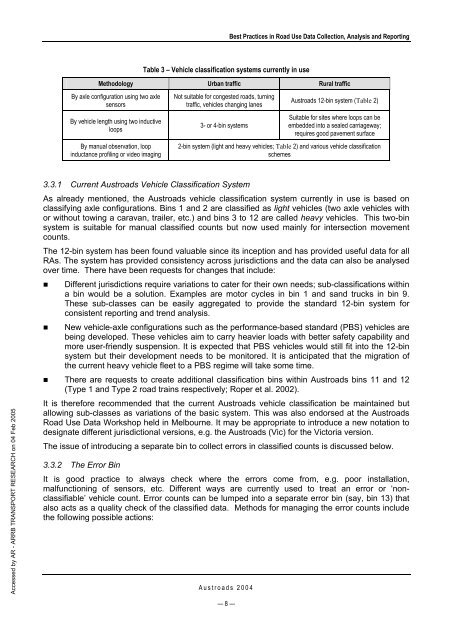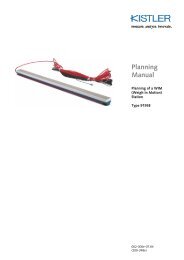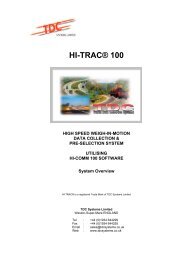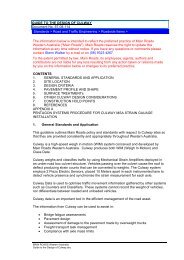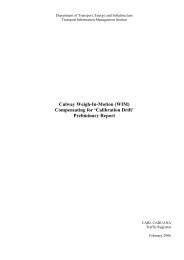AP-G84/04 Best practice in road use data collection, analysis ... - WIM
AP-G84/04 Best practice in road use data collection, analysis ... - WIM
AP-G84/04 Best practice in road use data collection, analysis ... - WIM
Create successful ePaper yourself
Turn your PDF publications into a flip-book with our unique Google optimized e-Paper software.
Accessed by AR - ARRB TRANSPORT RESEARCH on <strong>04</strong> Feb 2005<br />
Table 3 – Vehicle classification systems currently <strong>in</strong> <strong>use</strong><br />
Aust<strong>road</strong>s 20<strong>04</strong><br />
— 8 —<br />
<strong>Best</strong> Practices <strong>in</strong> Road Use Data Collection, Analysis and Report<strong>in</strong>g<br />
Methodology Urban traffic Rural traffic<br />
By axle configuration us<strong>in</strong>g two axle<br />
sensors<br />
By vehicle length us<strong>in</strong>g two <strong>in</strong>ductive<br />
loops<br />
By manual observation, loop<br />
<strong>in</strong>ductance profil<strong>in</strong>g or video imag<strong>in</strong>g<br />
Not suitable for congested <strong>road</strong>s, turn<strong>in</strong>g<br />
traffic, vehicles chang<strong>in</strong>g lanes<br />
3- or 4-b<strong>in</strong> systems<br />
Aust<strong>road</strong>s 12-b<strong>in</strong> system (Table 2)<br />
Suitable for sites where loops can be<br />
embedded <strong>in</strong>to a sealed carriageway;<br />
requires good pavement surface<br />
2-b<strong>in</strong> system (light and heavy vehicles; Table 2) and various vehicle classification<br />
schemes<br />
3.3.1 Current Aust<strong>road</strong>s Vehicle Classification System<br />
As already mentioned, the Aust<strong>road</strong>s vehicle classification system currently <strong>in</strong> <strong>use</strong> is based on<br />
classify<strong>in</strong>g axle configurations. B<strong>in</strong>s 1 and 2 are classified as light vehicles (two axle vehicles with<br />
or without tow<strong>in</strong>g a caravan, trailer, etc.) and b<strong>in</strong>s 3 to 12 are called heavy vehicles. This two-b<strong>in</strong><br />
system is suitable for manual classified counts but now <strong>use</strong>d ma<strong>in</strong>ly for <strong>in</strong>tersection movement<br />
counts.<br />
The 12-b<strong>in</strong> system has been found valuable s<strong>in</strong>ce its <strong>in</strong>ception and has provided <strong>use</strong>ful <strong>data</strong> for all<br />
RAs. The system has provided consistency across jurisdictions and the <strong>data</strong> can also be analysed<br />
over time. There have been requests for changes that <strong>in</strong>clude:<br />
Different jurisdictions require variations to cater for their own needs; sub-classifications with<strong>in</strong><br />
a b<strong>in</strong> would be a solution. Examples are motor cycles <strong>in</strong> b<strong>in</strong> 1 and sand trucks <strong>in</strong> b<strong>in</strong> 9.<br />
These sub-classes can be easily aggregated to provide the standard 12-b<strong>in</strong> system for<br />
consistent report<strong>in</strong>g and trend <strong>analysis</strong>.<br />
New vehicle-axle configurations such as the performance-based standard (PBS) vehicles are<br />
be<strong>in</strong>g developed. These vehicles aim to carry heavier loads with better safety capability and<br />
more <strong>use</strong>r-friendly suspension. It is expected that PBS vehicles would still fit <strong>in</strong>to the 12-b<strong>in</strong><br />
system but their development needs to be monitored. It is anticipated that the migration of<br />
the current heavy vehicle fleet to a PBS regime will take some time.<br />
There are requests to create additional classification b<strong>in</strong>s with<strong>in</strong> Aust<strong>road</strong>s b<strong>in</strong>s 11 and 12<br />
(Type 1 and Type 2 <strong>road</strong> tra<strong>in</strong>s respectively; Roper et al. 2002).<br />
It is therefore recommended that the current Aust<strong>road</strong>s vehicle classification be ma<strong>in</strong>ta<strong>in</strong>ed but<br />
allow<strong>in</strong>g sub-classes as variations of the basic system. This was also endorsed at the Aust<strong>road</strong>s<br />
Road Use Data Workshop held <strong>in</strong> Melbourne. It may be appropriate to <strong>in</strong>troduce a new notation to<br />
designate different jurisdictional versions, e.g. the Aust<strong>road</strong>s (Vic) for the Victoria version.<br />
The issue of <strong>in</strong>troduc<strong>in</strong>g a separate b<strong>in</strong> to collect errors <strong>in</strong> classified counts is discussed below.<br />
3.3.2 The Error B<strong>in</strong><br />
It is good <strong>practice</strong> to always check where the errors come from, e.g. poor <strong>in</strong>stallation,<br />
malfunction<strong>in</strong>g of sensors, etc. Different ways are currently <strong>use</strong>d to treat an error or ‘nonclassifiable’<br />
vehicle count. Error counts can be lumped <strong>in</strong>to a separate error b<strong>in</strong> (say, b<strong>in</strong> 13) that<br />
also acts as a quality check of the classified <strong>data</strong>. Methods for manag<strong>in</strong>g the error counts <strong>in</strong>clude<br />
the follow<strong>in</strong>g possible actions:


